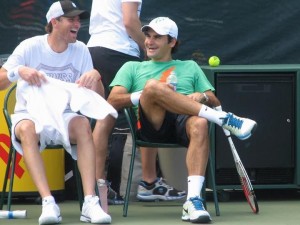By Thomas Swick
 “Seen any big names?” I asked the man at the entrance who every morning aims a machine at the barcode on my credentials.
“Seen any big names?” I asked the man at the entrance who every morning aims a machine at the barcode on my credentials.
“Federer,” he said. “He just walked by about two minutes ago.”
I headed off in the general direction and found the #3 player in the world hitting with Marin Cilic (#24). Tennis teachers usually tell you to play with people who are slightly better than you, so you can improve, but that’s difficult of course when there are only two.
It was 11:30 on a Thursday morning and the stands were filling quickly. Practice sessions are loved primarily by two types of people: autograph seekers, who get access they don’t during matches, and serious players, who get to see up close the drills and mechanics of the pros. The difference between watching a match and watching a practice is like the difference between admiring a watch and opening it up to see how it works.
I noticed the young Australian woman I’d seen at Cilic’s practice yesterday.
“Poor Cilic,” I said. “Everybody’s watching Federer, nobody’s watching him.”
“I’m watching him,” she said, then added: “It’s more sincere.”
I headed over to the media center to drop off my laptop and when I got back out to Court 5, Federer and Cilic were still at it. Next door on Court 4, Rafael Nadal was hitting with Richard Gasquet (Nadal having a slightly harder time than Federer finding someone superior). Though P.J. Shaw, standing at the top of the stands, thought it might get easier for the Spaniard.
“Federer’s going to beat him in the final,” he said confidently. “In straight sets.”
P.J. was 14, from Niceville, FL. “In the Panhandle,” I said. “That’s a nice town.” I chuckled at the redundancy.
Federer and Cilic were now playing points. Federer wore a blue T-shirt with a large tennis ball on the left side toward the bottom. The ball was using crutches, and had a heavily-bandaged leg and Band-Aids on its face.
“I hope to get his bandana,” P.J. said. “I got Berdych’s cap.”
He explained that he had just watched his other favorite player practicing, and only a handful of people had been in attendance. “I asked him if I could have his cap. He said ‘sure’ and he gave it to me. He’s really nice.
“Do you want to see it?” he asked me.
“Sure,” I said. This was my morning of repeating.
He dug in his bag and pulled out a damp white cap, the initials TB scribbled on the front.
“It’s still wet,” I said.
“Yea,” P.J. said. “The sweat of a champion.”
I asked him if there was anything he’d like me to ask Federer in a press conference.
“Add me on Facebook,” he answered immediately, then added: “I’m just kidding.” After some thought he said: “Ask him what his favorite shot is.”
Federer and Cilic were now shaking hands, signaling the end of their practice. “Alright,” P.J. said, grapping his heavily-autographed ball. “Game on.”
Walking to the Grandstand, a little before two, I saw a shirtless Tommy Haas hitting on a practice court and looking like he could have a career as an underwear model. I walked around to the neighboring court, where two women were rallying, both in shirts.
“Do you know who they are?” I asked a woman with a zoom.
“No,” she said, “I’m looking at the guys.”
Over in the Grandstand, Kim Clijsters had just won the final point against Julia Goerges, and her husband, standing outside near a lemonade stand, told their daughter: “Mommy’s coming out soon.”
At the nearby sunglass kiosk, a cardboard fan reading “God Is Good” poked out of the bag of a potential customer. When I asked about it, the young woman extracted it for examination; at the bottom it read: christiantennis.net.
“There are a lot of girls on the tour who don’t have any moral standards,” the twin sister, Rachel, said. I noted that there is really no Tim Tebow of tennis. (The closest you get are players – Del Potro, Baghdatis, Djokovic – crossing themselves or, in the case of Djokovic, kissing a cross worn around the neck.)
“There’s Anastasia Kharchenko,” Rachel said. “She’s in the top 500. If she had the platform, she would be like Tebow.”
I said goodbye to the sisters and headed to yet another practice court, where Mardy Fish was hitting with Viktor Troicki. A young woman named Roshni was sitting in the shade with “I <3 Djokovic” written in Sharpie on her left arm, while her friend Drishti was sporting, on the same arm, “I <3 Nadal.” Troicki’s T-shirt read “I <3 Miami.”
Back at Court 4, a small crowd awaited the arrival of Djokovic. Peni, a Thai woman now living in Australia, showed me her notebook, each page decorated with a different player’s initials, most of them so intricate and graceful that they brought to mind Chinese calligraphy. They were pretty enough to frame. (While skimping on the full signature, players have clearly put some thought into the distinct look of their initials.) Peni had written at the bottom of each page the player’s name, as the initials were usually penned more with thoughts of artistry than legibility. I asked her who ‘Tony’ was.
“Uncle Toni,” she said, then laughed.
I asked if she went to the Australian Open.
“Yes,” she said. “But it’s very crowded. Here it’s easier to get autographs.”
A woman from Fayetteville, Arkansas, told of seeing Victoria Azarenka earlier. “What a class act. She was the nicest person. She was talking to people, posing for pictures.” Though she hadn’t seen her, she had heard that Marion Bartoli was “fabulous.”
Twenty past four and there was still no sign of Djokovic. The Arkansan’s friend, a middle-aged woman, approached and said: “It’s too hot to be celebrity-obsessed.”
